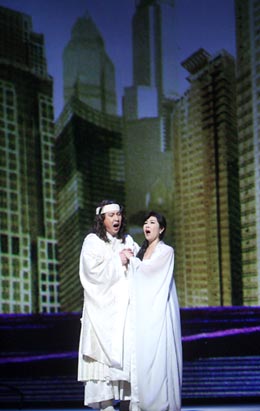Opera brings drama to Seoul history

Dosil (Kim Eun-kyung), right, and Ahreuk (Choi Sung-soo) sing in an opera that traces the history of Seoul from the Joseon Dynasty to today. [YONHAP]
The opera “Love Letter,” which is set primarily in the Gwanghwamun area, gives audiences a glimpse of this historical transformation. It is a dramatization of the history of Seoul told through the story of two young people who fall in love, are separated and then are reunited during three periods in Korean history. The story begins during the Joseon Dynasty, when Seoul was known as Hanyang, moves to the Japanese colonial period, when the city was renamed Kyungsung, and ends in the present day.
The opera was co-commissioned by the Seoul Metropolitan Government and the Sejong Center for the Performing Arts and is part of a project called “Seoul’s Representative Creative Performance,” which started in 2008 to promote Korean culture. The first performance created by the government and the center was the musical “Backstreet Matchmaker,” which premiered in September.
Eom Yeon-sook, director of Seoul’s Culture and Art Division, spoke about the opera at a press preview on Nov. 9. She said it took three years to bring all of the elements of the opera together.
“We wanted to show everything about Seoul - the places, the history and the love stories. We hope the public embraces the opera,” she said.
The story unfolds as Dosil, the daughter of a poor scholar, rejects the advances of Jaepil, a rich old man. After being rejected, Jaepil slanders the scholar and destroys the family, and Dosil is forced to work as a gisaeng, or Korean courtesan. One day, Ahreuk, a craftsman who makes silk, risks his life to save Dosil from a fire and she realizes that he has always loved her.
The production is directed by Park Se-won, a former opera singer who has starred in productions of “Tosca,” “La Traviata” and “Rigoletto.” He was awarded the Okguan Cultural badge by the government in 1985 for helping disseminate Korean culture overseas. He is currently the director of the Seoul Opera and a professor at Seoul National University.
“For the older generation, the opera evokes feelings of nostalgia about Seoul, and for the younger generation, it is a chance to understand how Seoul developed,” he said.
In addition to the lively music, the performance is notable for its colorful and iridescent costumes. Dosil is resplendent in the clothes and accessories of the time, and the craftsman’s silk lights up the stage.
In the first act, when Dosil sings about how her heart starts to beat when she sees silk, she coils the silk around her fingers, allowing the audience to almost feel the texture of the fabric through her movements.
The script was written by Jo Gwang-hwa, a theater veteran who received the Best Director and Best Script awards at the Korea Musical Awards in 2008 and was named Best Director at the first Musical Awards in 2007.
“This opera contains all the charm that Seoul has to offer - from the set design, which shows how Gwanghwamun has changed over the years, to the costumes,” she said.
*The opera runs from Dec. 1 to 4 at the Sejong Center for the Performing Arts’ Grand Theatre. Performances are at 7:30 p.m. on weekdays and at 3 and 7:30 p.m. on Saturday. Tickets are from 10,000 won ($8.79) to 70,000 won. Go to Gwanghwamun Station, line No. 5, exit 1 or 8. Call (02) 399-1114~6, or visit www.sejongpac.or.kr.
By Lee Sun-min [summerlee@joongang.co.kr]










with the Korea JoongAng Daily
To write comments, please log in to one of the accounts.
Standards Board Policy (0/250자)